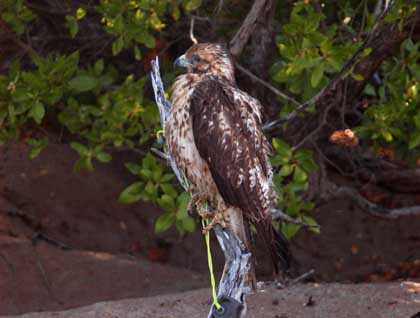As we approached Espumilla Beach at Santiago Island we could see a small bird perching on a tree. It got bigger and bigger as we got closer: a Galapagos hawk was waiting for us, motionless. It looked at us with curiosity. The hawk was probably waiting for some young turtles to emerge from the nearby nests, as this beach is also the place where Pacific green turtles lay their eggs. The evidence was there: several tracks of recent incursions on the beach were the testimony of their activity during the last hours.
After everyone photographed the hawk, it was time to begin our excursion to the island, hiking between mangroves and a thick forest, then uphill where we had a great view of the bay and the islands nearby and then back to the beach. Instead of spotting one hawk where we left it, we found 4 hawks perching close to our backpacks. One had decided to land at the same place where a radio was hanging, so we had to wait until it decided to fly to the next branch and then pick up the radio. We had news from another group that they saw a little turtle emerging from its nest and crawling to the ocean, but a Galapagos hawk caught it and later ate it. Explorers could see the struggle of life and death, right in front of them.
After we returned from the walk it was time have breakfast and get more energy for the next activity, snorkeling in the pristine waters of the Galapagos Islands. After dropping in the water several divers saw two white tip reef sharks and several king angelfish. The seas were calm and the water clear, so it was a very relaxing time for everyone.
During the afternoon we visited Puerto Egas. Landing on a beautiful black ash beach, we were received by several sea lions that looked very relaxed on the beach. Some were nursing, others playing in a small tide pool. A short and easy hike took us to the Fur Seals Grotto, where several of these animals were resting on small rocks. One decided it was time to jump in the water and get a little bit of swimming.
On the way back to the beach we hiked along the coastline where several marine iguanas were laying almost on top of each other sneezing every now and then. Others were just arriving from feeding on the algae present on the nearby rocks and slowly crawled and joined the bigger group.
An oystercatcher moved along the rocks looking for some small invertebrates to eat, while a yellow warbler slowly moved toward us as it fed on insects next to a tide pool.
The day finished with the sun setting between two of the volcanos to the west on the northern part of Isabela Island. Several pelicans flew by as the sun set, an impressive finale for a day with memories that will last a lifetime.









